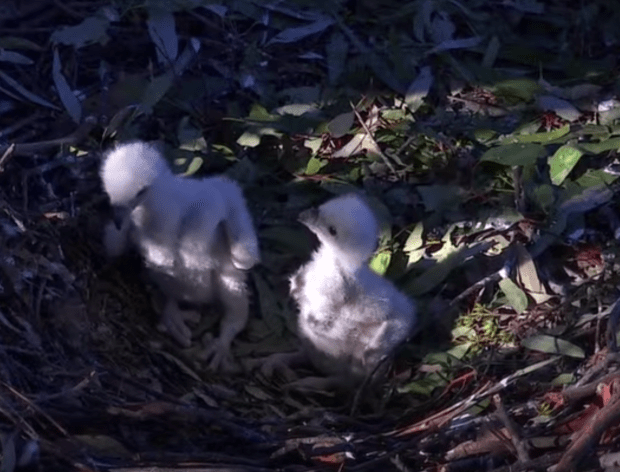It is difficult to suppress the tears because of the enormous outpouring over the death of Malin. A reader from Japan wrote, “It is raining in Collins Marsh, but in Japan it is called “rain of tears” and is considered to be rain that falls in times of sorrow. I hope from Japan that the nest environment will improve. I sincerely pray for the repose of Malin ‘s soul.”

Someone else wrote: “I grieve for Malin. I was watching the live cam and turned to do something for a minute and when I returned my gaze, he was gone! I had to scroll back to see what happened because I just saw mom on the nest looking agitated.
Malin was on his way to being a beautiful osprey and needed extra time because he was underdeveloped. I am so sad. Thank you for your post.
Malin’s soul has journeyed to “just this side of Heaven…a place called Rainbow Bridge. Whenever a bird dies,that bird goes to the Rainbow Bridge…at the Rainbow Bridge there are meadows and hills and beautiful trees of all kinds where our special friends can fly…play…and singing together. There is plenty of good food…There is crystal clear water in brooks and springs are filled with water….Those who were hurt or maimed or ignored…are made whole and strong and free of fear again, just as we remember them in our dreams of days gone by.”
So soar high, beautiful Malin. No worries now because you will always have a fresh supply of fish to fill his crop.”
Another writes, “his little bird that sat in the nest, day after day, mostly alone, unprotected for the most part from blistering sun or rain just captured our hearts for his bravery and persistence. I now accept the sad fact that he is gone……..but not forgotten. I hope there are answers forthcoming to address your questions, and mine.”
Still another that I know loves Malin deeply and who was involved in his naming writes, “This is very sad about Malin. We all loved Malin. May He Rest In Peace. Thanks for the beautiful photo of Malin on the nest and all the info.May God Bless all birds and animals who need help and May they always be in the right place to get that help.”
Those comments appear in the comment section of my blog. E-mails have filled by inbox. I am so grateful for your outpouring of love for Malin. A good friend of our birds writing from Latvin, says that she learned to love Malin so much through the stories of his day to day struggles. She is saddened and upset that he has been taken away because of some bureaucratic mixup. I certainly think we all feel that way. So many have written to say just how sad they are at Malin’s passing and how much joy he brought to them. Of the ones I have also read you have talked about the nest environment of Malin. I appreciate that. As you know I have had continual concerns over access to the nest in case of an emergency. There is no perch for the parent. Sadly, Marsha found a tiny twig she could use one day. I was informed that no one wants to take the nest down and disturb all of the work of the birds but, in fact, the Snowy Owls in the winter have done much to rid the nest of its twigs, etc. This nest needs attention at all levels. You are all so right.
I know that there was surprise at Collins Marsh that so many people knew about Malin and cared for him. The love for Malin have joined people from around the world. Today we grieve and remember. Tomorrow we work so that all non-humans are respected and cared for – so that our planet can get its balance back. We do it in memory of our little Malin. Here is a short video of a fish delivery for Malin:

I will not be able to answer each and everyone of the e-mails in my inbox today but I am grateful to the outpourings of love for Malin and I will answer each and every one as soon as I can. Thank you!
QUICK UPDATE IN OTHER NEWS: All of the storklings have fledged from the nests of Grafs and Jan. Karl II has joined his 3 on migration. There is concern over one of the fledglings. I will discuss this tonight. The second egg has been laid at Collins Marsh. The dominant behaviour has stopped again at the WBSE nest. It looks as if the osprey chick at the Minnesota Landscape nest has fledged but I cannot confirm the date or time currently. It did not spend the night on the nest and because of Malin I have no watched as carefully as I might normally. Details on all of these later today.
Credit for feature image is: “Rainbow and the rain” by Ryan Ojibway is licensed under CC BY-NC 2.0




































































































